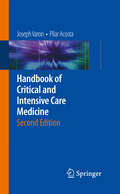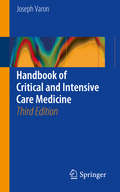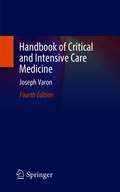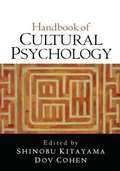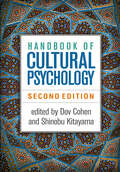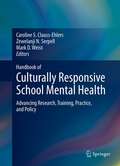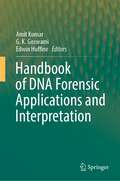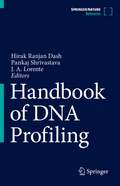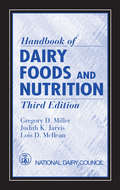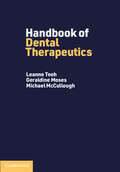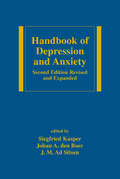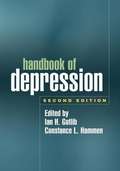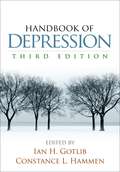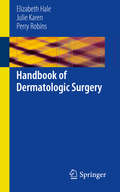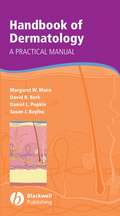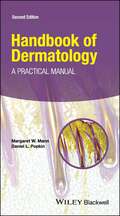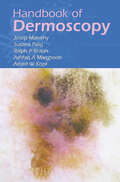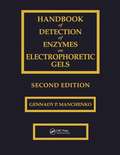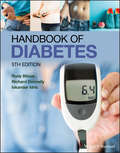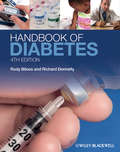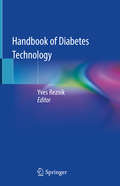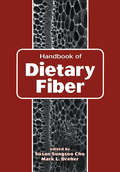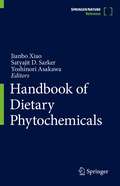- Table View
- List View
Handbook of Critical Incidents and Essential Topics in Pediatric Anesthesiology
by David A. Young Olutoyin A. OlutoyeThis practical handbook is the first resource written by practicing pediatric anesthesiologists that provides the reader with a bedside reference for managing critical incidents and for effectively mastering the key topics within pediatric anesthesiology. The first main section of the book addresses critical incidents related to the anesthetic management of pediatric patients. Listed in alphabetical order to allow rapid retrieval by the reader, each Critical Incident follows a concise, standardized format, covering presentation, risk factors, differential diagnosis, pathophysiology, management, and prevention. The second section consists of nearly 100 Essential Topics. Bullet points, key phrases and tables provide a focused and efficient review format. Written and edited by experts from top children's hospitals, this is an essential resource for residents and fellows seeking to master the key topics, as well as a valuable quick-reference handbook for more experienced anesthesiologists caring for pediatric patients.
Handbook of Critical and Intensive Care Medicine
by Joseph Varon Pilar AcostaThe Handbook of Critical and Intensive Care Medicine, second edition, is a comprehensive, user-friendly guide for physicians, residents, and healthcare practitioners who cover the ICU. The book's up-to-date information includes frequently performed procedures and therapeutic guidelines that have great efficacy and relevance in everyday ICU rotations. The book is divided into sections based on organ system, and each chapter uses an outline format and numerous tables and charts for quick and easy reference.
Handbook of Critical and Intensive Care Medicine
by Joseph VaronThe latest edition of this handbook is a concise yet comprehensive guide for attending physicians, fellows, residents, and students who cover the ICU. The chapters follow an outline format and are divided by organ system, including neurologic disorders and cardiovascular disorders, and special topics, such as environmental disorders, trauma, and toxicology. The handbook includes thoroughly updated chapters from the previous edition, alongside completely new material. Written by an authority in the field, the Handbook of Critical and Intensive Care Medicine, Third Edition is a valuable one-stop reference for every practitioner engaged in Critical Care Medicine across the world.
Handbook of Critical and Intensive Care Medicine
by Joseph VaronThe latest edition of this handbook is a concise yet comprehensive guide for attending physicians, fellows, residents, and students who cover the ICU. The chapters follow an outline format and are divided by organ system, including neurologic disorders and cardiovascular disorders, and special topics, such as environmental disorders, trauma, and toxicology. The handbook includes thoroughly updated chapters from the previous edition, alongside completely new content.Written by an authority in the field, the Handbook of Critical and Intensive Care Medicine, Fourth Edition is a valuable one-stop reference for every practitioner engaged in Critical Care Medicine across the world.
Handbook of Cultural Psychology
by Shinobu Kitayama Dov CohenBringing together leading authorities, this definitive handbook provides a comprehensive review of the field of cultural psychology. Major theoretical perspectives are explained, and methodological issues and challenges are discussed. The volume examines how topics fundamental to psychology-identity and social relations, the self, cognition, emotion and motivation, and development-are influenced by cultural meanings and practices. It also presents cutting-edge work on the psychological and evolutionary underpinnings of cultural stability and change. In all, more than 60 contributors have written over 30 chapters covering such diverse areas as food, love, religion, intelligence, language, attachment, narratives, and work.
Handbook of Cultural Psychology, Second Edition
by Shinobu Kitayama Dov CohenNow completely revised (over 90% new), this handbook offers the authoritative presentation of theories, methods, and applications in the dynamic field of cultural psychology. Leading scholars review state-of-the-art empirical research on how culture affects nearly every aspect of human functioning. The volume examines how topics fundamental to psychology--such as cognition, emotion, motivation, development, and mental health--are influenced by cultural meanings and practices. It also addresses the psychological and evolutionary underpinnings of cultural stability and change. The second edition reflects important advances in cultural neuroscience and an increasing emphasis on application, among many other changes. As a special bonus, purchasers of the second edition can download a supplemental e-book featuring several notable, highly cited chapters from the first edition. New to This Edition: *Most chapters are new, reflecting nearly a decade of theoretical and methodological developments. *Cutting-edge perspectives on culture and biology, including innovative neuroscientific and biopsychological research. *Section on economic behavior, with new topics including money, negotiation, consumer behavior, and innovation. *Section on the expansion of cultural approaches into religion, social class, subcultures, and race. *Reflects the growth of real-world applications in such areas as cultural learning and adjustment, health and well-being, and terrorism.
Handbook of Culturally Responsive School Mental Health
by Mark D. Weist Zewelanji N. Serpell Caroline S. Clauss-EhlersSchools across the United States - as well as much of the world - are experiencing widespread change. Students are more diverse ethnically, academically, and emotionally. More attention is being paid to abuse and neglect, violence and bullying, and the growing inequities that contribute to student dropout. Within this changing landscape, cultural competence is imperative for school-based professionals, both ethically and as mandated by educational reform. The Handbook of Culturally Responsive School Mental Health explores the academic and behavioral challenges of an increasingly diverse school environment, offering workable, cost-effective solutions in an accessible, well-organized format. This timely volume updates the research on cultural competence in school-based interventions, describes innovative approaches to counseling and classroom life, and demonstrates how this knowledge is used in successful programs with children, adolescents, and their families. Populations covered range widely, from African American and Asian American/Pacific Islander families to forced migrants and children who live on military bases. By addressing issues of training and policy as well as research and practice, contributors present a variety of topics that are salient, engaging, and applicable to contemporary experience, including: - Adolescent ethnic/racial identity development. - Culturally responsive school mental health in rural communities. - Working with LGBT youth in school settings. - Cultural competence in work with youth gangs. - Culturally integrated substance abuse prevention and sex education programs. - Promoting culturally competent school-based assessment. - School-based behavioral health care in overseas military bases. - Developmental, legal, and linguistic considerations in work with forced migrant children. - Cultural considerations in work/family balance. The Handbook of Culturally Responsive School Mental Health is a must-have reference for researchers, scientist-practitioners, educational policymakers, and graduate students in child and school psychology; educational psychology; pediatrics/school nursing; social work; counseling/therapy; teaching and teacher education; and educational administration.
Handbook of DNA Forensic Applications and Interpretation
by Amit Kumar G. K. Goswami Edwin HuffineThis handbook covers tested and proven DNA forensic testing methodologies, forensic bioinformatics techniques, case studies and current forensic legal framework for investigation of variety of crimes and provides a clinching evidence for speedy justice. DNA testing is widely used for forensic purposes and is changing the paradigm of (crime) investigation. The book contains chapters on usage of ultramodern DNA collection kits, presents era evidence collection and preservation, high-end DNA sample analysis in laboratory, DNA legislation, expert evidences, challenging and successful case studies, data generation and application of AI and IoT techniques for DNA data analysis, DNA databanks and training manpower to facilitate timely reporting to the requesting agencies. This handbook equips and enables police, investigators and crime analysis laboratories with knowhow of high-end tools, procedures and techniques to link or exclude a criminal to a crime. It is expected that this will be used by first responders, police, forensic analysts, judiciaries, evidence handlers and students and scholars of criminology and forensic sciences worldwide. The intention to write this handbook is to make DNA technology and its importance reach every common man and professional for correctly using it as a tool as and when required. This is quite evident that awareness of DNA technology has increased at a reasonable pace. Courts and investigating agencies are convinced and confident with its accuracy, reliability and unmatched peace delivered by various techniques of DNA fingerprinting and DNA profiling.
Handbook of DNA Profiling
by Hirak Ranjan Dash Pankaj Shrivastava J. A. LorenteThis reference book comprehensively reviews the significance of DNA technology in forensic science. After presenting the theory, basic principles, tools and techniques that are used in forensic DNA typing, it summarizes various techniques, including autosomal STR, Y-STR, X-STR, mitochondrial DNA and NGS, used in solving both criminal as and civil cases, such as paternity disputes, identification of mutilated remains, and culprit identification in sexual assault and murder cases. It also provides an overview of DNA-based genetic diagnostics for various diseases, and discusses the role of DNA typing in drug reactions, as well as the application of non-human DNA profiling of animals and plants in forensic science investigations. Lastly, the book examines the role of internal quality control in maintaining the high quality of DNA profiling.
Handbook of Dairy Foods and Nutrition
by Gregory D. Miller Judith K. Jarvis Lois D. McBeanHandbook of Dairy Foods and Nutrition, Third Edition examines the role of dairy products in diet and health, covering such areas as cardiovascular health, hypertension, cancer, bone, and oral health. This edition features a new chapter on dairy foods and weight management. Other chapters address lactose digestion and the contribution of dairy foods to health throughout the lifecycle. All chapters contain updated (or new) data, content, and references. With peer-reviewed chapters by nutrition and medical experts, this book remains the most subsidized reference on dairy and nutrition currently available.
Handbook of Dementing Illnesses (Neurological Disease and Therapy)
by James E. Galvin John C. Morris David M. HoltzmanAn up-to-date survey of the major dementing disorders, this guide provides the most recent clinical, epidemiological, and neurodiagnostic information related to the care and treatment of dementing illnesses-addressing subjects of vital importance such as ethics, neuropsychology, neuroimaging, and neuropathology to stand as the foremost guide on the
Handbook of Dental Therapeutics
by Leanne Teoh Geraldine Moses Michael McCulloughDentists require a comprehensive understanding of drugs used in clinical practice in order to safely prescribe and manage medication use in their patients. Handbook of Dental Therapeutics provides practical coverage of drugs in dentistry. This text draws together the latest recommendations for Australia and Aotearoa New Zealand, covering common drugs dentists administer and prescribe, perioperative management considerations, oral adverse effects and drug safety. Dedicated chapters on how therapeutics affect children, pregnant and breastfeeding women, and elderly patients enable readers to prescribe and administer medications across the lifespan. Concisely written, the text is a practical guide which includes dosage recommendations and practice points. Diagrams, graphs and tables summarise complex information to ensure readers have readily accessible information on the drugs most commonly used in dentistry. Handbook of Dental Therapeutics is an essential text that equips dental students and dentists with succinct, clinically relevant information about all aspects of drugs in dentistry.
Handbook of Depression and Anxiety: A Biological Approach, Second Edition (Medical Psychiatry Series)
by Siegfried Kasper Johan A. den Boer J. M. Ad SitsenFeatures new to the second edition of this handbook include measurement scales used in research, breakthroughs in pharmacogenomics, epidemiology, genetics, psychophysiology and pharmacology, and enhanced therapeutic strategies and outcome measures for patient care and management.
Handbook of Depression, Second Edition
by Ian Gotlib Constance HammenBringing together the field's leading authorities, this acclaimed work is widely regarded as the standard reference on depression. The Handbook provides comprehensive coverage of the epidemiology, course, and outcome of depressive disorders; issues in assessment and diagnosis; psychological and biological risk factors; effective approaches to prevention and treatment; and the nature of depression in specific populations. Each chapter offers a definitive statement of current theories, methods, and research findings, while also identifying key questions that remain unanswered.
Handbook of Depression, Third Edition
by Constance L. Hammen Ian H. GotlibThe authoritative reference on depression and mood disorders, this volume brings together the field's preeminent researchers. All aspects of unipolar and bipolar depression are addressed, from genetics, neurobiology, and social-contextual risk factors to the most effective approaches to assessment and clinical management. Contributors review what is known about depression in specific populations, exploring developmental issues across the lifespan as well as gender and cultural variables. Effective psychosocial and biological treatments are described in detail. Each chapter offers a definitive statement of current theories, methods, and findings, and identifies key questions that remain to be answered. New to This Edition *Incorporates cutting-edge research (including findings from international, multisite, integrative, and longitudinal studies), treatment advances, and changes to diagnostic criteria in DSM-5. *Chapters on comorbidity with anxiety disorders and emotional functioning in depression. *Expanded coverage of bipolar disorder, now the focus of three chapters (clinical features, risk and etiological factors, and treatment). *Many new authors and extensively revised chapters.
Handbook of Dermatologic Surgery
by Elizabeth Hale Julie Karen Perry RobinsThe Handbook of Dermatologic Surgery incorporates the most cutting edge technology applicable to dermatologists and dermatologic surgeons today. Designed as a reference guide for dermatologic surgery and aesthetic procedures, it disseminates key scientific information in an easy-to-use pocket book. This handbook is designed to be readily transportable for dermatologists and dermatologic surgeons, as well as those in training, dermatology residents and fellows, and medical students rotating through dermatology.
Handbook of Dermatology: A Practical Manual
by Daniel L. Popkin David R. Berk Susan J. Bayliss Margaret W. MannBecause dermatology is a complex visual specialty that mixes medical and surgical approaches to management, trainees need fast access to a wide range of material. This concise new reference uses tables, algorithms, protocols, guidelines, and staging and scoring systems to present succinct guidance on best-practice patient care. Structured around three components -- medical, surgical, and pharmacological -- the book consolidates the core Board exam information residents most often look up. Handbook of Dermatology: A Practical Manual was road-tested as it was developed to ensure usefulness for dermatology residents, dermatologists, and family physicians.
Handbook of Dermatology: A Practical Manual
by Margaret W Mann Daniel PopkinThe Handbook of Dermatology consolidates the essential information required for best-practice patient care into one pocket-sized volume. This indispensable reference guide enables practicing and prospective dermatologists to easily look up information on a wide range of dermatological diseases and quickly access the algorithms, protocols, guidelines, and staging and scoring systems that are vital to both clinical practice and exam success. Written and edited by former residents and attending physicians, the Handbook contains up-to-date information on general dermatology, surgery, and therapeutics.
Handbook of Dermoscopy
by Ashfaq A. Marghoob Josep Malvehy Ralph P. Braun Susana Puig Alfred W. KopfThe rise in popularity of dermoscopy has meant that more and more practitioners need a ready reference to consult in a clinical setting where larger atlases are less practical. The Handbook of Dermoscopy features a wealth of photographs, checklists, and algorithms to assist in spot diagnoses. Coverage includes melanocytic lesions, seborrheic kerato
Handbook of Detection of Enzymes on Electrophoretic Gels
by Gennady P. ManchenkoStill widely used as gene markers, isozymes detected by zymogram techniques have proven valuable in a range of other biological applications over the last few years. Along with these new applications, many new techniques have also emerged. Yet more than eight years since the Handbook of Detection of Enzymes on Electrophoretic Gels was first publish
Handbook of Diabetes
by Richard Donnelly Rudy Bilous Iskandar IdrisThe Handbook of Diabetes provides concise and efficient coverage of the diagnosis, epidemiology, and management of diabetes and its complications. Containing hundreds of attractive colour diagrams, illustrations, and clinical photographs, this popular quick-reference guide focuses on the management and measurement of diabetes mellitus with highly visual references. Now in its fifth edition, this market-leading book aligns with the most recent guidelines from the American Diabetes Association (ADA), the European Association for the Study of Diabetes (EASD), Diabetes UK, and the National Institute for Health and Care Excellence (NICE), presenting authoritative clinical coverage of diabetes in an accessible format with rich pedagogical features. Five new chapters provide detailed coverage of liver disease, diabetes education, bariatric surgery, diabetes and cancer, and the use of incretin-based therapies and SGLT2 Inhibitors in the management of Type II diabetes Updated and expanded topics include the relation between hypoglycaemia and dementia, anxiety and depression, the NICE Quality and Outcomes Framework (QOF), and the impacts of diabetes to self-care, mental health, and decision-making Provides a wealth of pedagogical features such as vignettes and case histories, important learning points, summaries of key clinical trials, and links to further readings Handbook of Diabetes, remains the essential practical companion for all health professionals involved in managing patients with diabetes, and an up-to-date reference for diabetes and endocrinology researchers, scientists, and academics.
Handbook of Diabetes
by Richard Donnelly Rudy BilousOver three editions the Handbook of Diabetes has built a reputation as an essential practical manual on the assessment and management of patients with diabetes. Previously written by Gareth Williams and John Pickup, the book has been completely revised by Rudy Bilous and Richard Donnelly to reflect recent changes in diabetes treatment and care. It contains information on the new IFCC units for measuring blood glucose and the latest drugs being used to combat diabetes, as well as alternative methods of insulin delivery. The book has been fully updated and redesigned to make it even more user-friendly, and contains case histories, practice points, and landmark clinical trials highlighted in color in each chapter where appropriate. It also features an entirely new set of 250 clinical photographs. The Handbook of Diabetes is the ideal practical handbook for all health professionals with an interest in diabetes care.
Handbook of Diabetes Technology
by Yves ReznikThis book covers the main fields of diabetes management through applied technologies. The different chapters include insulin therapy through basic insulin injection therapy, external and implantable insulin pumps and the more recent approaches such as sensor augmented pumps and close-loop systems. Islet transplantation is also described through its technical aspects and clinical evaluation. Glucose measurement through blood glucose meters and continuous glucose monitoring systems are comprehensively explained. Educational tools including videogames and software dedicated to diabetes management are depicted. Lastly, Telemedicine systems devoted to data transmission, telemonitoring and decision support systems are described and their use for supporting health systems are summarized. This book will help professionals involved in diabetes management understanding the contribution of diabetes technologies for promoting the optimization of glucose control and monitoring. This volume will be helpful in current clinical practice for diabetes management and also beneficial to students.
Handbook of Dietary Fiber: An Applied Approach (Food Science And Technology Ser. #Vol. 25)
by Susan Sungsoo Cho; Mark L. DreherPresents the latest research on the analysis, metabolism, function, and physicochemical properties of fiber, fiber concentrates, and bioactive isolates--exploring the effect of fiber on chronic disease, cardiovascular health, cancer, and diabetes. Examines food applications and the efficacy and safety of psyllium, sugar beet fiber, pectin, alginate, gum arabic, and rice bran.
Handbook of Dietary Phytochemicals
by Satyajit D. Sarker Yoshinori Asakawa Jianbo XiaoThis book summarizes recent advances in the chemistry, bioactivity, nutrition, and functional aspects of dietary phytochemicals, as well as the health and functional aspects of foods rich in phytochemicals. Consisting of forty-four chapters, it discusses the different chemical types of phytochemicals in our diets and food and presents data collected from animal or human experiments that are directly related to human health. Each chapter covers the chemistry, epidemiological study, bioavailability, bioactivity (animal experiments) function in humans and safety, as well as products on the market. Moreover, the more than 200 figures make it easy to grasp the main findings in each area.

